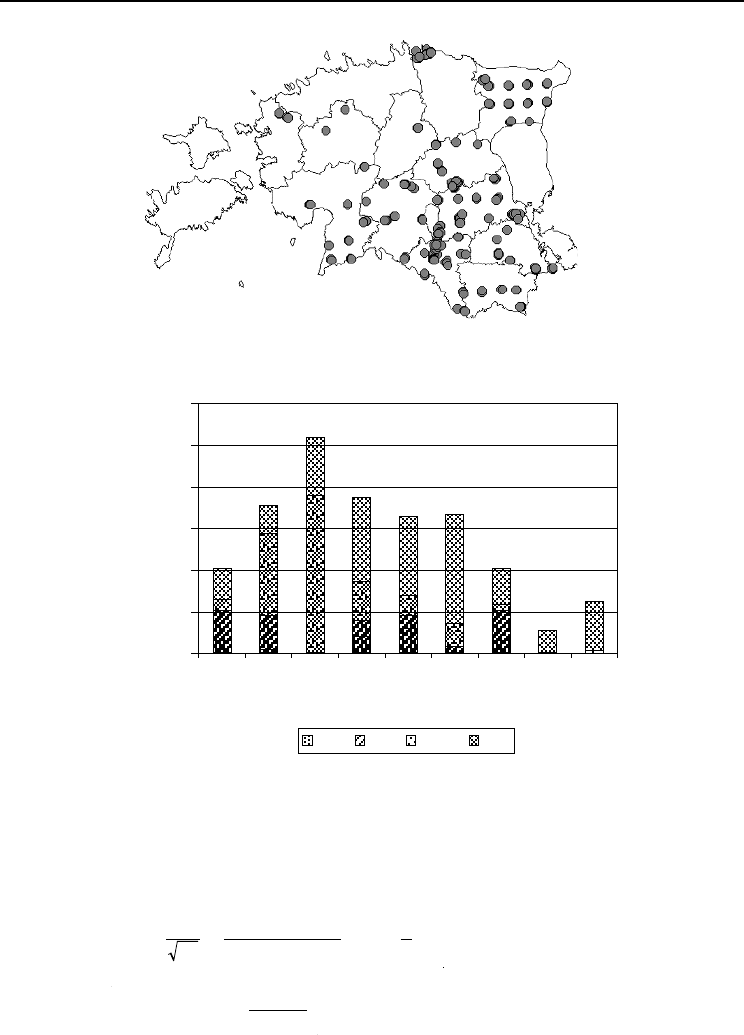Amaro A., Reed D., Soares P. (editors) Modelling Forest Systems
Подождите немного. Документ загружается.


16Amaro Forests - Chap 14 25/7/03 11:06 am Page 166
166 R.A. Fleming and T.R. Burns
length) outweighs the effect of reduced light availability limiting foliage production
in the lower crown. (Stand thinning probably weakened this latter effect.)
Acknowledgements
We thank Bo Långström for organizing accommodation at Jädraås and Stockholm
through the Swedish University of Agricultural Sciences, and for arranging financial
support through the Swedish Royal Academy of Agriculture and Forestry (KSLA).
We thank STORA Skog for permission to work at their premises.
References
Anderson, T.W. and Darling, D.A. (1954) A test for goodness of fit. Journal of the American
Statistical Association 49, 765–769.
Axelsson, B. and Bråkenhielm, S. (1980) Investigation sites of the Swedish Coniferous Forest
Project – biological and physiographical features. In: Persson, T. (ed.) Structure and
Function of Northern Coniferous forests: an Ecosystem Study. Ecological Bulletins 32, 25–64.
Draper, N.R. and Smith, H. (1981) Applied Regression Analysis. Wiley, New York, 709 pp.
Ericsson, A., Larsson, S. and Tenow, O. (1980) Effects of early and late season defoliation on
growth and carbohydrate dynamics in Scots pine. Journal of Applied Ecology 17, 747–769.
Ericsson, A., Hellqvist, C., Långström, B., Larsson, S. and Tenow, O. (1985) Effects on growth of
simulated and induced shoot pruning by Tomicus piniperda as related to carbohydrate and
nitrogen dynamics in Scots pine. Journal of Applied Ecology 22, 105–124.
Fleming, R.A. (2001) The Weibull model and an ecological application: describing the dynam-
ics of foliage biomass on Scots pine. Ecological Modelling 138(1–3), 309–320.
Fleming, R.A. and Piene, H. (1992a) Spruce budworm defoliation and growth loss in young
balsam fir: period models of needle survivorship for spaced trees. Forest Science 38(2),
287–304.
Fleming, R.A. and Piene, H. (1992b) Spruce budworm defoliation and growth loss in young
balsam fir: cohort models of needlefall schedules for spaced trees. Forest Science 38(3),
678–694.
Flower-Ellis, J., Albrektsson, A. and Olsson, L. (1976) Structure and Growth of Some Young Scots
Pine Stands. 1. Dimensional and Numerical Relationships. Technical Report 3, Swedish
Coniferous Forest Project, Uppsala, Sweden.
Harper, J.L. and Bell, A.D. (1979) The population dynamics of growth and form in organisms
with modular construction. In: Anderson, R.M., Turner, B.D. and Taylor, L.R. (eds)
Population Dynamics. Blackwell, Oxford, pp. 29–52.
Kalbfleisch, J.D. and Prentice, R.L. (1980) The Statistical Analysis of Failure Time Data. Wiley,
New York, 321 pp.
Långström, B. (1980) Distribution of pine shoot beetle attacks within the crown of Scots pine.
Studia Forestalia Suecica 154, 1–25.
Långström, B., Tenow, O., Ericsson, A., Hellqvist, C. and Larsson, S. (1990) Effects of shoot
pruning on stem growth, needle biomass, and dynamics of carbohydrates and nitrogen in
Scots pine as related to season and tree age. Canadian Journal of Forest Research 20, 514–523.
Långström, B., Piene, H., Fleming, R. and Hellqvist, C. (1998) Shoot and needle losses in Scots
pine: experimental design and techniques for estimating needle biomass of undamaged
and damaged branches. In: McManus, M.L. and Liebhold, A.M. (eds) Proceedings:
Population Dynamics, Impacts, and Integrated Management of Forest Defoliating Insects.
General Techical Report NE-247. USDA Forest Service, Northeastern Research Station,
Radnor, Pennsylvania, pp. 230–246.
Levene, H. (1960) Robust tests for equality of variances. In: Ingram, O., Hoeffding, W., Ghurye,
S.G., Madow, W.G. and Mann, H.B. (eds) Contributions to Probability and Statistics. Stanford
University Press, Stanford, California, pp. 278–292.

16Amaro Forests - Chap 14 25/7/03 11:06 am Page 167
167 Allometric-Weibull Model for Foliage Biomass
Lyytikäinen-Saarenmaa, P. (1999) Growth responses of Scots pine (Pinaceae) to artificial and
sawfly (Hymenoptera: Diprionidae) defoliation. Canadian Entomologist
131, 455–463.
Mann, H.B. and Whitney, D.R. (1947) On a test of whether one of two random variables is sto-
chastically larger than the other. Annals of Mathematical Statistics 18, 50–60.
Pienaar, L.V. and Turnbull, K.J. (1973) The Chapman–Richards generalization of von
Bertalanffy’s growth model for basal area growth and yield in even-aged stands. Forest
Science 19, 2–22.
Piene, H. (1983) Nondestructive estimation of foliar biomass in balsam fir. Canadian Journal of
Forest Research 13, 672–677.
Piene, H. and Fleming, R.A. (1996) Spruce budworm defoliation and growth loss in young bal-
sam fir: spacing effects on needlefall in protected trees. Forest Science 42, 282–289.
Ralston, M. (1992) Derivative-free nonlinear regression. In: Dixon, W.J. (ed.) BMDP Statistical
Software Manual. University of California Press, Berkeley, California, pp. 427–455.
Skre, O. and Nes, K. (1996) Combined effects of elevated winter temperatures and CO
2
on
Norway spruce seedlings. Silva Fennica 30, 55–63.
Sprugel, D.G. (1983) Correcting for bias in log-transformed allometric equations. Ecology 64,
209–210.
Sprugel, D.G., Hinckley, T.M. and Schaap, W. (1991) The theory and practice of branch auton-
omy. Annual Review of Ecology and Systematics 22, 309–334.
Zar, J.H. (1996) Biostatistical Analysis. Prentice-Hall, Upper Saddle River, New Jersey, 918 pp.
16Amaro Forests - Chap 14 25/7/03 11:06 am Page 168

17Amaro Forests - Chap 15 25/7/03 1:54 pm Page 169
15 Diameter Distribution Models
and Height–Diameter Equations
for Estonian Forests
A. Kiviste,
1
A. Nilson,
1
M. Hordo
1
and M. Merenäkk
1
Abstract
To study the structure and growth of Estonian forest stands, a network of 501 permanent sam-
ple plots was established in 1995–2001. The plots were placed randomly using the grid of the
European forest monitoring program ICP FOREST. The network of permanent plots covers the
main forest types and actual age interval of commercial forests. The plots are to be re-mea-
sured at 5-year intervals.
The plots are circles holding a minimum of 100 trees each. On the plots, the polar coordi-
nates and breast height diameters of all trees are measured. Additionally, the total height and
crown length of selected sample trees are also measured. To date, the measurement data for
90,209 trees have been recorded in the database.
The aim of the permanent plot network is to create and recalibrate Estonian forest-growth
models. However, to achieve this, long-term measurement series on the permanent plots are
still required. Nevertheless, on the basis of the existing material, some forest structure models
have been tested and developed for Estonia, such as: (i) diameter distribution models and (ii)
height–diameter models.
The Johnson’s SB distribution was flexible enough to describe the diameter distributions
of Estonian forests. Regression methods of parameter estimation represented a better fit than
percentile methods. A diameter distribution model, the parameters of which were predicted by
stand variables, has been developed for Estonian forests.
A standardized height–diameter equation has been created for Estonian forests.
Depending on the number of height–diameter measurements, the equation can be used as a
one-parameter or two-parameter model. Model parameters can be estimated by solving a sys-
tem of linear equations.
Introduction
Models of forest stand growth and structure are the basis for planning forest man-
agement activities such as cutting, thinning and regeneration. At the Estonian State
Forest Management Centre, a computer-based decision-support system is being
1
Estonian Agricultural University, Estonia
Correspondence to: akiviste@eau.ee
© CAB International 2003. Modelling Forest Systems (eds A. Amaro, D. Reed and P. Soares) 169

17Amaro Forests - Chap 15 25/7/03 1:54 pm Page 170
170 A. Kiviste et al.
developed. Both adequate forest stand descriptions and stand growth and structure
models are needed for the effective use of the system.
The current Estonian forest structure and growth models are poor (Nilson,
1999). T
o make the computer-based decision-support system work, many tempo-
rary models based on old tables generalized for large regions (e.g. the Orlov site
index tables, the Tretyakov standard tables) or on limited empirical data have
been used. It is expected that more accurate models will soon be produced by
Estonian forest researchers to replace the incomplete models in the system.
The stand growth models based on the distance-independent individual tree
gr
owth models used in the Finnish
MELA (Hökka, 1997; Hynynen et al., 2002) and
Swedish
HUGIN (Hägglund, 1981) would be acceptable types of growth model in the
computer-based decision-support system. However, much effort is required to
establish and maintain long-term observations on permanent forest growth plots.
An all-Estonian network of permanent forest growth plots has been designed after a
similar Finnish system (Gustavsen et al., 1988) to provide empirical data for the
models. At present, the network consists of 501 plots, 193 of which have already
been re-measured.
According to Finnish results (Hynynen et al.
, 2002), for reliable forest growth
modelling, data from at least 3–4 plot re-measurements (over 15–20 years) are
required. Nevertheless, the collected plot data can be used for the modelling of
Estonian forest structure. This chapter presents our first attempts to use the collected
material for modelling of diameter distribution and height–diameter relationships
for Estonian forests.
Materials and Methods
Data collection
Thousands of plots have been established in Estonian forests over many decades.
Most of them ar
e subjectively located temporary plots. However, construction of
forest growth models using data from subjectively located temporary plots is prob-
lematical. In 1999, the National Forest Inventory (NFI) was started in Estonia. The
NFI permanent plots have been optimized to estimate Estonian forest area and vol-
ume. Having a radius of only 10 m, they are, however, too small to reliably charac-
terize stand regularities for research purposes. A new method of establishing a
network of permanent forest growth plots has been developed by the Institute of
Forest Management of the Estonian Agricultural University. The following princi-
ples were used for designing the network of permanent forest growth plots.
1. A long series of re-measured permanent plots would provide the best data for the
modelling of for
est stand growth.
2. All basic forest types and age and density classes should be represented through-
out Estonia.
3. Plots should be located randomly.
4. In addition to measurements of trees, tree coordinates on plots should be deter-
mined in or
der to find the same trees at the next re-measuring and to enable the con-
struction of both distance-independent and distance-dependent models.
5. Forest growth plots should be large enough to clearly characterize stand regularities.
The method of establishing permanent forest growth plots is mainly based on the
experience of the Finnish For
est Research Institute (Gustavsen et al., 1988). Some rec-
ommendations from Curtis (1983) were taken into consideration. The codes of species,

17Amaro Forests - Chap 15 25/7/03 1:54 pm Page 171
171 Diameter Distribution Models
site types, faults and measurement units were taken from the Estonian NFI guidelines
(Estonian Forest Survey, 1999). The following procedures characterize the method.
1. The compartments for plots were selected before the beginning of fieldwork
accor
ding to the desired plot distribution. For the placement of plot regions, the grid
of the European forest-monitoring program
ICP FOREST 1 was used. Also, the grid of
the Estonian National Forest Inventory was used to place plot centres. To save on
transport costs, two or three survey pairs worked together in the same plot region.
2. All trees were measured on circular plots with a radius of 15, 20, 25 or 30 m to get
at least 100 first-stor
ey trees. Smaller trees (second-storey and understorey trees)
were measured in an inner circle with a radius of 8 m (the surrounding circle 15 m)
or 10 m (the surrounding circle more than 15 m).
3. Measurements on plots were carried out by pairs of researchers. The recorder at
the plot centr
e measured the azimuth and the measurer measured the distance from
the plot centre, breast height diameter in two directions, and the faults of each tree.
The measured trees were marked with a coloured spot at a height of 1.3 m. Every
fifth tree, dominant trees, trees of rare species and trees in the inner circle were mea-
sured as sample trees. For sample trees, the total height, the crown height and the
height of dead branches were also measured. Crown height was defined as height of
the lowest live contiguous whorl. In addition to living trees, the coordinates and
diameters of standing dead trees and fresh stumps were measured.
4. The main instruments for tree measurements were a compass, a calliper and a
‘For
estor Vertex’ hypsometer.
5. The age of stand components was determined by counting tree rings from cores
extracted fr
om sample trees. The thickness of the soil organic layer was measured at
several places on the plot.
6. A metal stick was used to mark the plot centre. In addition, a couple of trees near
the plot centr
e were marked with a coloured circle for easier location in 5 years time.
The geographical coordinates of plot centres were determined using a GPS device.
The plots and their neighbouring objects (roads, ditches, rocks, etc.) were mapped.
In Estonia, the first permanent forest growth plots, with tree coordinates, were
established by Urmas Peterson in the Pikknurme and
Aakre forest districts (Central
Estonia) in 1995/96. In 1997/98, plots of the same type were established in the Sagadi
forest district (North Estonia) and in several areas of South Estonia. During those years,
various instruments and methods were tried and, as a result, an optimal fieldwork
technique was developed. In 1999, a network of permanent forest growth plots to cover
the whole of Estonia was designed. Figure 15.1 shows that most of Estonia is already
covered by plots. In the summer of 2002, more than 100 forest growth plots were estab-
lished in north-west Estonia and on some Estonian islands. With that, the first round of
measuring was finished. At present, a total of 501 forest growth plots have been estab-
lished in the network, 193 of which have already been re-measured. Figure 15.2 shows
the distribution of plots by dominant species and age classes. Our database includes a
total of 90,209 tree measurements, 70,002 of which pertain to the first layer. The number
of model trees is 28,441. Most of them (22,993) are first-layer trees.
Analysis
Diameter distribution
Various density functions have been used for the modelling of diameter distribu-
tions. Most often, normal, log-normal, W
eibull, Gram–Charlier, γ, β and Johnson’s
distributions have been fitted. In this study, we selected Johnson’s SB distribution as

17Amaro Forests - Chap 15 25/7/03 1:54 pm Page 172
172 A. Kiviste et al.
80
60
40
20
0
20 30 40 50 60 70 80 90 >100
Age class
120
100
Number of plots
Other Birch Spruce Pine
⋅−
⋅
)
ε
(
)
−
+−
⋅+ −
εελ
d
ελ
λ
−
(
⋅
δ
π
2
=
γ
Fig. 15.1. Network of permanent forest growth plots in Estonia established in 1995–2001. Each circle on
the map marks a group of plots.
Fig. 15.2. Distribution of permanent forest growth plots by dominant species and age classes.
one of the most flexible among the classical distribution functions (Tarve, 1986;
Kamziah et al., 1999).
The density function of Johnson’s SB distribution (1949) is
2
γδ
where z =+⋅ ln
d
and δ are shape parameters, ε and λ are location and scale parameters, d is tree
breast height diameter (cm).
In this study, six methods were tested for the estimation of Johnson’s SB distrib-
ution parameters.
1. Four percentile (4PR) method (Slifker and Shapiro, 1980). According to this method,
parameter estimates ar
e calculated from four symmetrical points (−3z, −z, z, 3z).
z
1
2
exp
x d
fd( )

17Amaro Forests - Chap 15 25/7/03 1:54 pm Page 173
173 Diameter Distribution Models
On the basis of 436 Estonian forest plot data points, the optimal value z = 0.972 was
used.
2. Knoebel and Burkhart’s (1991) (KB) method. According to this method, the lower
limit, range, median and 95th per
centile of the observed diameter distributions were
used for parameter estimation.
3. Moments (MOM) method (Bowman and Shenton, 1983). According to this
method, the lower limit, range, arithmetic mean and standar
d deviation of the
observed diameter distributions were used for parameter estimation.
4. Maximum likelihood (MLE) method (Zhou and McTague, 1996) with predeter-
mined
ε and λ using the Knoebel and Burkhart (1991) method.
5. Linear regression (LIN) method (Zhou and McTague, 1996). According to this
method, the parameters
ε and λ were predetermined using Knoebel and Burkhart’s
(1991) method, and the shape parameters γ and δ were calculated from 10%, 20%,
…,90% percentiles using linear regression.
6. Non-linear regression (NLIN) method (Kamziah et al.
, 1999). According to this
method, the parameters ε and λ were predetermined using Knoebel and Burkhart’s
(1991) method, and the shape parameters γ and δ were calculated from all points
using Marquardt non-linear regression procedure
NLIN (SAS, 1989).
Kolmogorov–Smirnov (KS) statistics were calculated and goodness-of-fit tests
(Zar
, 1999) at the significance level α = 0.05 were performed for each distribution
and parameter estimation method.
Height–diameter relationships
In this study we wanted to develop a standard equation for use in the procedure of
appr
oximation of plot height–diameter data in the Estonian forest-management
decision-support system. A considerable number of different equations have been
used for the approximation of height–diameter relationships (e.g. Huang et al., 2000).
The equations having parameters that can be estimated using the linear regression
technique are preferred for practical use. Root mean square errors (RMSEs) of 27 dif-
ferent height–diameter equations used on the Estonian forest plot data (Mängel,
2000) were compared. Several equations had almost the same (minimum) residual
standard error. Finally we settled on the model developed by Professor A. Nilson:
H
h =
D
c
1 −⋅
−
b
1
d
where h is the tree height in m, d is the tree breast height diameter in cm, D is the
quadratic mean diameter in cm, and c is a constant (1.31 for pine, 1.47 for spruce
and 1.38 for other species).
Equation parameters H and b can be calculated fr
om the following system of
linear equations:
n n
Hn
b⋅+⋅
∑
z ⋅ =
∑
h
i
i
h
i
i=1 i=1
n n n
H ⋅
∑
z +⋅
∑
z
i
⋅ =
∑
z
i
⋅hb
2
h
i i
i
i=1 i=1 i=1
D
c
1
where
z
i
=−
,
d
i
and h
i
are the diameter and height of the ith sample tree, and
d
i
D is the quadratic mean diameter (cm).

17Amaro Forests - Chap 15 25/7/03 1:54 pm Page 174
174 A. Kiviste et al.
Results
Diameter distribution
For the modelling of diameter distributions, first-storey trees of the dominant
species wer
e selected from each plot. The plots holding less than 56 first-storey trees
of the dominant species were excluded from the analysis of distributions. As a
result, 436 diameter distributions, with 52,608 trees, were selected. Table 15.1 pre-
sents summary statistics of the 436 diameter distributions used in this study.
Kolmogorov–Smirnov (KS) statistics were calculated and goodness of fit tests
wer
e performed for each diameter distribution and parameter estimation method.
Table 15.2 presents the means and standard deviations of parameter estimates and the
KS statistics with the numbers of passes of goodness-of-fit tests. Figure 15.3 shows
box-and-whiskers plots of KS statistics by different parameter estimation methods
A comparison of methods applied to Estonian forest plot data showed that the
r
egression methods (LIN and NLIN) for parameter estimation represented the best
fit. The methods based on certain percentiles (KB and 4PR) were unstable. For both
methods, about 10% of plots did not pass the Kolmogorov–Smirnov goodness-of-fit
test, and for the four percentile (4PR) method the parameter estimation failed in
four cases. The moments (MOM) method and the maximum likelihood (MLE) meth-
ods represented a slightly worse fit than the regression methods; however, they are
simpler to apply.
Table 15.1. Summary statistics of 436 diameter distributions used in this study.
Characteristic Mean Minimum Maximum
Number of trees 121 56 378
Average diameter 17.1 4.6 37.1
Standard deviation 4.7 1.6 9.4
Coefficient of variation 29.9 13.8 72.1
Skewedness 0.51 −0.59 4.1
Kurtosis 0.23 −1.13 23.5
Table 15.2. Arithmetic means and standard deviations (
SD) of Johnson’s SB distribution parameters and
Kolmogorov–Smirnov (KS) statistics on the basis of data from 436 plots. A plot passes the test when the
null hypothesis (H
0
) fails to be rejected.
Method ε
Parameters
λ γ
KS test (α = 0.05)
KS Number of
δ statistic passes (H
0
) %
4PR
KB
MOM
MLE
LIN
NLIN
Mean
SD
Mean
SD
Mean
SD
Mean
SD
Mean
SD
Mean
SD
7.39
4.50
6.89
4.47
5.73
3.12
5.73
3.12
5.73
3.12
5.73
3.12
28.67
21.65
26.31
7.20
30.70
9.97
30.70
9.97
30.70
9.97
30.70
9.97
0.87
0.86
0.64
0.41
0.82
0.35
0.81
0.35
0.85
0.41
0.87
0.42
1.18
0.40
1.20
0.20
1.35
0.25
1.36
0.24
1.41
0.28
1.41
0.29
0.079
0.029
0.084
0.032
0.064
0.019
0.067
0.020
0.060
0.017
0.056
0.015
393
399
434
436
436
436
90.0
91.5
99.5
100
100
100

17Amaro Forests - Chap 15 25/7/03 1:54 pm Page 175
175 Diameter Distribution Models
4PR
KB
MOM
MLE
LIN
NLIN
0.00 0.04 0.08 0.12 0.16 0.20 0.24
Kolmogorov–Smirnov (KS) statistic
Fig. 15.3. The box and whiskers plot of Kolmogorov–Smirnov (KS) statistics for different methods.
Using the general linear method procedure (GLM) of the SAS software (SAS,
1989), equations to predict Johnson’s SB distribution parameters from stand vari-
ables were developed. Initially, all main stand variables (site type, site index, stand
age, dominant species, average height, quadratic mean diameter, basal area, relative
density, number of trees per hectare and indicator of thinning) were analysed as
independent variables in the model. Finally, only significant variables at a signifi-
cance level of α = 0.05 were included. Table 15.3 presents the variables and parame-
ter estimates of linear models for the prediction of the minimum and the maximum
diameters of first-layer trees in stands.
The standard deviation of diameter STD can be predicted using the following
equation:
STD = 0.006 + 0.294·MAX – 0.233·D
where MAX is the maximum diameter (cm), and D is the quadratic mean diameter
(cm).
Table 15.3. Parameter estimates of linear models for the prediction of the minimum (MIN) and the
maximum (MAX) diameters of first-layer trees from stand variables.
Stand variable MIN MAX
Intercept according to dominant species
Pine −3.88 7.78
Spruce −4.02 8.59
Birch −3.43 7.68
Aspen −3.21 6.71
Common alder −1.87 5.26
Grey alder −2.66 6.10
Site index H
100
(m), base age 100 years 0.0730 −0.1085
Quadratic mean diameter D (cm) 0.6553 1.2499
Number of trees per hectare (N) 0.000285 −0.000577
Relative density of stand T (by Tretyakov) −1.67 3.05
Indicator of thinning (thinned 1, otherwise 0) 0.31 0
Coefficient of determination (R
2
) 0.89 0.92
RMSE 1.56 2.60
